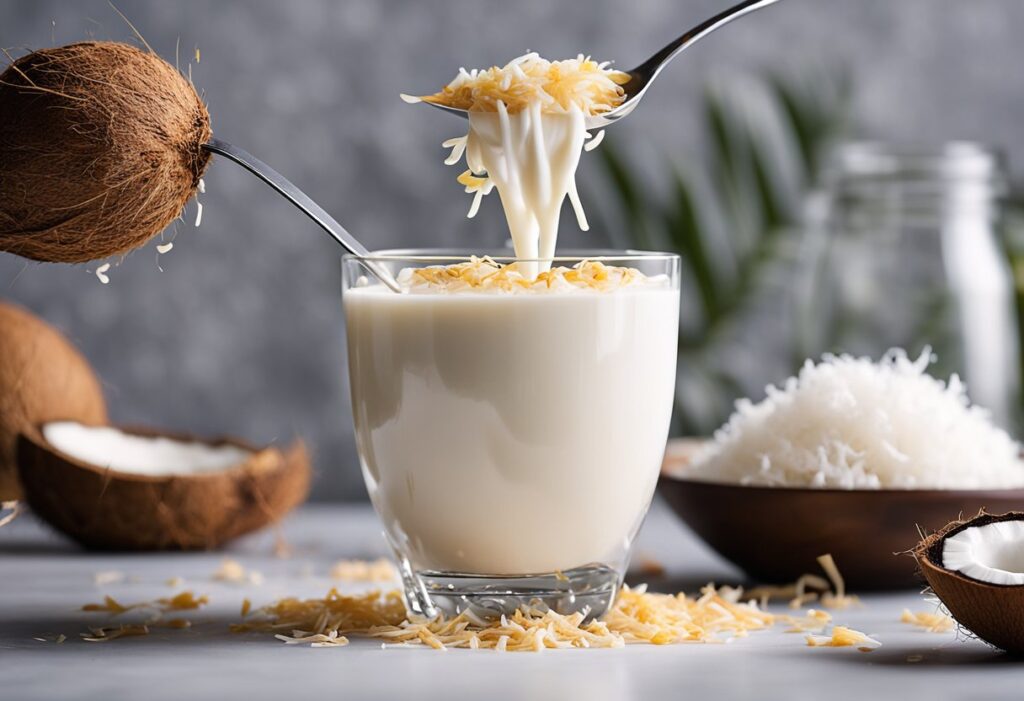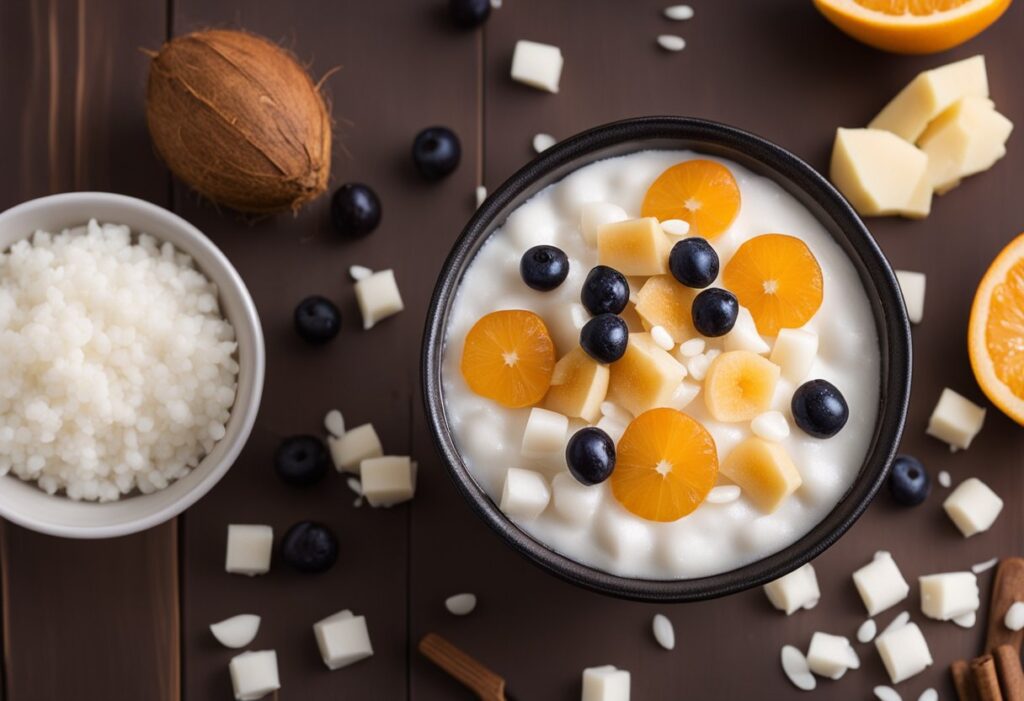Coconut milk is a versatile ingredient that can be used in a variety of dishes, including desserts. Coconut milk is a creamy liquid extracted from grated coconut flesh and is commonly used in Southeast Asian cuisine. It is a popular ingredient in vegan and dairy-free recipes as it provides a rich, creamy texture without the use of dairy products.
Table of Contents

Coconut milk desserts are a delicious way to enjoy the unique flavor of coconut. From creamy puddings to rich ice creams, there are many different types of desserts that can be made with coconut milk. Coconut milk can also be used to add flavor to baked goods, such as cakes and cookies. Whether you are looking for a dairy-free alternative or simply love the taste of coconut, there are many delicious coconut milk dessert recipes to choose from.
Essential Ingredients for Coconut Milk Desserts

Types of Coconut Milk
Coconut milk is a key ingredient in making delicious desserts. There are two types of coconut milk: thick and thin. Thick coconut milk is made by blending grated coconut with water and then straining it. It has a creamy texture and a strong coconut flavor. Thin coconut milk is made by diluting thick coconut milk with water. It has a lighter texture and a milder coconut flavor.
When making coconut milk desserts, it is important to choose the right type of coconut milk based on the recipe. Thick coconut milk is ideal for making custards, puddings, and ice creams, while thin coconut milk is better suited for soups and curries.
Sweeteners
Sweeteners are an essential ingredient in coconut milk desserts. They add flavor and sweetness to the dish. There are several types of sweeteners that can be used in coconut milk desserts, including sugar, honey, maple syrup, and agave nectar.
When choosing a sweetener, it is important to consider the flavor profile of the dessert. For example, if the dessert has a strong coconut flavor, a mild sweetener like honey or maple syrup may be a better choice than sugar, which can overpower the coconut flavor.
Binding Agents
Binding agents are ingredients that help hold the dessert together. They are important in making desserts like cakes, bars, and cookies. Some common binding agents used in coconut milk desserts include eggs, flour, and cornstarch.
When choosing a binding agent, it is important to consider the texture and consistency of the dessert. For example, if the dessert is intended to be light and fluffy, eggs may be a good choice. If the dessert is intended to be dense and chewy, flour or cornstarch may be a better choice.
Popular Coconut Milk Dessert Recipes
Coconut Milk Pudding
Coconut milk pudding is a popular dessert that is enjoyed by many people around the world. It is a creamy and delicious dessert that is easy to make and can be enjoyed by people of all ages. To make coconut milk pudding, you will need coconut milk, sugar, cornstarch, and vanilla extract.
To prepare the pudding, mix the cornstarch and sugar in a saucepan and gradually stir in the coconut milk. Cook the mixture over medium heat until it thickens, stirring constantly. Once the mixture has thickened, remove it from the heat and stir in the vanilla extract. Pour the mixture into individual serving dishes and refrigerate until set.
Coconut Milk Ice Cream
Coconut milk ice cream is a dairy-free alternative to traditional ice cream that is both delicious and healthy. It is made with coconut milk, sugar, and vanilla extract, and can be flavored with a variety of different ingredients, such as fresh fruit, chocolate, or nuts.
To make coconut milk ice cream, mix the coconut milk, sugar, and vanilla extract in a blender until smooth. Pour the mixture into an ice cream maker and churn according to the manufacturer’s instructions. Once the ice cream is ready, transfer it to a container and freeze until firm.
Coconut Milk Rice Pudding
Coconut milk rice pudding is a popular dessert that is enjoyed in many parts of the world. It is made with rice, coconut milk, sugar, and spices, and can be flavored with a variety of different ingredients, such as fruit, nuts, or chocolate.
To make coconut milk rice pudding, cook the rice in coconut milk and water until it is soft and creamy. Add sugar and spices, such as cinnamon or nutmeg, and cook the mixture until it thickens. Once the pudding is ready, transfer it to individual serving dishes and chill in the refrigerator until set.
Step-by-Step Cooking Techniques
Simmering Coconut Milk
Simmering coconut milk is a crucial step in creating a creamy and delicious dessert. To do this, start by pouring the coconut milk into a saucepan and heating it over medium heat. Be sure to stir the milk constantly to prevent it from scorching or boiling over. Once the milk comes to a gentle simmer, reduce the heat to low and let it simmer for 10-15 minutes. This will help infuse the milk with any additional flavors you may have added, such as vanilla or cinnamon.
Thickening Desserts
To thicken your coconut milk dessert, you can use a variety of techniques depending on the recipe. One option is to use cornstarch, which can be mixed with a small amount of water to create a slurry that is added to the simmering coconut milk. Another option is to use agar agar, a natural thickener that is derived from seaweed. Agar agar can be added directly to the coconut milk and simmered until it thickens. Alternatively, you can use egg yolks to create a custard-like consistency. To do this, whisk the egg yolks together with sugar and slowly add the hot coconut milk while whisking constantly. Then, return the mixture to the saucepan and heat over low heat until it thickens.
Chilling and Setting
Once your coconut milk dessert is thickened to your desired consistency, it’s time to chill and set it. Depending on the recipe, you may need to pour the mixture into individual serving dishes or a larger container. Then, cover the dish with plastic wrap and place it in the refrigerator to chill for at least a few hours or overnight. This will allow the dessert to set and become firm. If you want to speed up the process, you can also place the dessert in the freezer for a shorter amount of time. Just be sure to check on it frequently to prevent it from freezing solid.
Health Benefits and Dietary Considerations
Lactose-Free Alternatives
Coconut milk is a great lactose-free alternative for those who are lactose intolerant or have a milk allergy. It is made from the meat of mature coconuts and is naturally free from lactose. Coconut milk can be used in place of dairy milk in many recipes, including desserts, without compromising on taste or texture.
Vegan-Friendly Options
Coconut milk is also a vegan-friendly option for those who follow a plant-based diet. It is a rich source of healthy fats and can be used as a substitute for cream in many recipes. Coconut milk can be used to make a variety of vegan desserts, including ice cream, pudding, and whipped cream.
Caloric Content
Coconut milk is high in calories and fat, so it should be consumed in moderation. One cup of canned coconut milk contains around 445 calories and 48 grams of fat. However, it is also a good source of medium-chain triglycerides (MCTs), which are easily digested and converted into energy by the body. MCTs have been linked to increased metabolism and weight loss.
In summary, coconut milk is a great lactose-free and vegan-friendly alternative to dairy milk in desserts. However, it should be consumed in moderation due to its high caloric and fat content.
Serving and Presentation
Garnishing Tips
When it comes to garnishing your coconut milk dessert, there are a variety of options to choose from. Fresh fruits such as sliced strawberries, kiwi, or mango can add a pop of color and flavor to your dish. You can also use toasted coconut flakes, chopped nuts, or edible flowers to add texture and visual appeal. Be creative and experiment with different garnishes to find the perfect combination for your dessert.
Pairing with Beverages
Coconut milk desserts pair well with a variety of beverages. For a refreshing option, try serving your dessert with a cold glass of iced tea or lemonade. If you prefer something warm, a cup of coffee or tea can complement the rich flavors of the coconut milk. For a more indulgent pairing, consider serving your dessert with a glass of sweet dessert wine.
Plating Techniques
The presentation of your coconut milk dessert is just as important as the taste. Consider using a decorative plate or bowl to showcase your dessert. You can also use a piping bag to create elegant swirls or shapes with whipped cream or frosting. Don’t forget to add your garnishes strategically to create a visually appealing dish. With these plating techniques, your coconut milk dessert will look as good as it tastes.
Storage and Shelf Life
Coconut milk desserts can be stored in an airtight container in the refrigerator for up to five days. It is important to note that the texture and flavor of the dessert may change over time, especially if it contains fresh fruits or delicate ingredients.
If you plan on storing your coconut milk dessert for a longer period, it is recommended to freeze it. Coconut milk desserts can be frozen for up to three months without compromising their quality. However, it is important to thaw the dessert slowly in the refrigerator to prevent the separation of ingredients and loss of texture.
When storing coconut milk desserts, it is important to keep them away from strong-smelling foods as they can easily absorb odors. It is also recommended to label the container with the date of preparation to keep track of its freshness.
It is important to check the expiration date of the coconut milk used in the recipe before preparing the dessert. Canned coconut milk has a longer shelf life than fresh coconut milk and can be stored for up to two years in a cool and dry place. However, once opened, it should be refrigerated and used within a few days.
By following these simple storage and shelf life guidelines, you can enjoy your delicious coconut milk dessert for longer without compromising its quality and taste.
Troubleshooting Common Issues
Separation Problems
Coconut milk can sometimes separate, leaving a layer of cream on top and a watery layer on the bottom. This can happen if the coconut milk is old or if it has been stored at too high or low temperatures. One way to prevent separation is to shake the can well before using it. If separation still occurs, try stirring the coconut milk back together before using it in your recipe.
Texture Corrections
If your coconut milk dessert is too thick, you can thin it out by adding a little bit of water or coconut water. On the other hand, if your dessert is too thin, you can thicken it by simmering it gently over low heat until it reduces to the desired consistency. Be sure to stir it frequently to prevent burning.
Flavor Balancing
Coconut milk can have a strong flavor that may overpower other ingredients in your dessert. To balance the flavor, try adding a little bit of sugar or honey to sweeten it. You can also add a pinch of salt to enhance the flavor. If the coconut flavor is still too strong, try using a lighter coconut milk or diluting it with another type of milk.
Remember that troubleshooting common issues in coconut milk desserts is all about experimentation and finding the right balance of ingredients. With a little practice, you can create delicious desserts that are sure to impress your friends and family.

